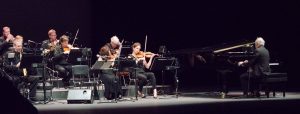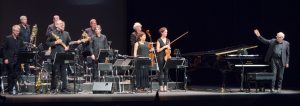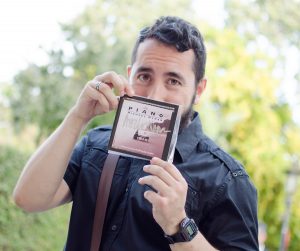Michael Nyman’s concert in Seville (Spain)
On May 22nd, 2018, the English composer Michael Nyman closed the musical season of the Teatro Lope de Vega in Seville (Spain) with a big hit. The box office had a poster saying SOLD OUT, leaving the trace of how beloved the composer is in the city of Seville. Nyman was already there on 2016 (May 6th, nearly two years ago) opening the international programming of the Espacio Box Sevilla.
BUT… WHO’S MICHAEL NYMAN?
Michael Nyman is one of the most innovative and acclaimed British composers whose work covers operas, string quartets, soundtracks, and orchestral concerts. Being more than a mere composer he is also a performer, conductor, pianist, writer, musicologist, photographer and filmmaker. Considered a “man of the Renaissance”, his creative restlessness and his artistic polyvalence have made him one of the most fascinating and influential cultural icons of our time.
Born on March 23rd, 1944, he studied composition with academician Thurston Dart, an expert in Baroque music at the King’s College of London.
An extensive collaboration with film director Peter Greenaway (“The cook, the thief, his wife and her lover”, “The Draughtsman’s Contract” and “Prospero’s Book”, among other titles) or the acclaimed Jane Campion’s “THE PIANO” (1993) (fantastic music that the composer had the generosity to sign me in a casual meeting with him before the concert) made him settle among the most talented movies composers of our time.
He has been nominated by the British Academy – BAFTA and has also received nominations for the Golden Globes. He is a composer away from Hollywood blockbuster movies. However, he has among his scores some feature films; “Gattaca” (Andrew Niccol), “Ravenous” (Antonia Bird) and “The End of the Affair” (Neil Jordan), being most of his work for European films.
Many of Nyman’s works have been written for his own ensemble, the Michael Nyman Band, which was created in 1976 for a Carlo Goldoni production named ‘Il Campiello’. The ensemble was originally composed of old instruments such as the rebec and the chirimia along with modern instruments such as the saxophone (included to get the loudest sound possible without using amplification), but went on to use an amplified string quartet, three saxophones, trombone bass, double bass, and piano. A band that has been modified for some works, but has remained stable since then, and has given Michael Nyman’s music a unique sound.
ONE STEP FORWARD, THREE STEPS BACKWARDS… SIR NYMAN
My hype and expectations for the concert were very high. Everything was looking good; maestro Nyman, his band, and listening live to the soundtrack he created for a documentary directed by him: “War Work: 8 Songs with Film”.
WAR WORK: 8 SONGS WITH FILM
Taking the poetry of the First World War as his inspiration, Nyman has created here an eloquent song cycle (“a film essay”, as he describes it), presented in two groups of four songs, each preceded by several instrumental movements. All the texts were written by poets who, with the exception of the English artist and poet David Bomberg, sadly lost their lives during the First World War.
The starting point of the music is the title of a series of poems by the French writer Gaston de Ruyter (shot down on October 7th, 1918) – ‘Chansons vielles sur d’autre airs’ (‘Old songs for other melodies’). The “chansons vielles” are poems by English, French, German and Hungarian poets (mostly sung in their original languages) and the “autres airs” are by English, French, German, Austro-Hungarian, Polish and Italian composers of the 17th and 19th centuries.
In the days before the concert, and as a documentation work, I was listening to the music in an isolated way and I tried to find the documentary, to watch it and understand what the musician tried to express through the combination of music and image. The latter was impossible for me, and I attended the concert totally in love with music, but without watching the complete audiovisual project.
MICHAEL NYMAN BAND LIVE
Once all the musicians were correctly placed in their positions, the maestro came on stage to get a huge applause.
His piano was on the right side of the stage and from his position, the virtuoso pianist was playing it with his left hand while using the right hand to conduct the mini-orchestra that is the band. Something that I had never witnessed in symphonic film music concerts. A joy for those present, and something amazing for the viewer who knew how to appreciate that staging.
During the first three pieces played in the concert, an omnipresent Michael Nyman delighted us with recognizable music; beautiful melody, with different dramatic nuances, and with some epic and dreamy virtuosity.
After a first part (to differentiate blocks in the concert) the light went down in intensity to leave space for the projection. My astonishment was that the projection in which we were going to submerge was the documentary “WAR WORK: 8 SONGS WITH FILM”. At last, I was going to be able to watch the documentary and with his original music live…
The projection began with a black background and some white letters that read “Directed by Michael Nyman”. I confess that I was excited, as my search for that documentary would have its reward in the best possible scenario.
But first let’s see a text taken from the official website of the composer:
Let’s make it clear: I totally disagree with the last sentence. I do not detract from the historical value of the very powerful images and videos shown in the documentary, but the brilliance that the author has as a musician is ballasted as a filmmaker.
The documentary is a succession of photos and videos that move your insides due to their harshness, but as a whole, it is nonsense. A music with a dramatic energy that is incapable of embracing images and making sense. Images and music follow different directions, opposite directions, impossible to cohere.
The absence of a voice-over or intertitles, which was a fundamental resource in the silent cinema, would have helped the viewer to digest a failed documentary, flooded with excellent music, which was not at the service of what we were seeing.
So I must confess that what was supposed to be the stimulating addition of the image to the music, became at times tedious. And I say at times, because I made the decision to disconnect from the images and focus on music that was incredible and which I fell in love with. I fixed my eyes on the impeccable orchestra, on the energetic voice of Marie Angel, and on the precise ability to play and conduct all at the same time of Sir Michael Nyman.
Despite the aforementioned, at the end of the show I stood up as the most enthusiastic spectator, to accompany ALL the people present, who melted in the most affectionate applause that lasted five minutes (in my case, just for the music.
Article by Rafael Melgar
Pictures by MissSoez · Ilustración y Diseño













